Aging: Exploring Theories and Stages of Life from Birth to Death
VerifiedAdded on 2022/09/17
|7
|1777
|38
Essay
AI Summary
This essay examines the various stages of human life, from pre-birth to death, emphasizing the physical and mental development that occurs throughout the aging process. It discusses the 12 stages of life, highlighting the unique features of each phase. The essay delves into Erik Erikson's theory of aging, which identifies old age as a stage of integrity versus despair. Furthermore, it explores Gene Cohen's perspective on aging, which emphasizes positive growth and development. Cohen's four stages of maturity—Midlife Re-evaluation, Liberation, Summing Up, and Final Phase—are discussed, illustrating how individuals experience personal growth and adaptation throughout their lives. The essay concludes by highlighting the differences between modern and early conceptions of life stages, emphasizing the influence of scientific and societal factors in shaping our understanding of aging.
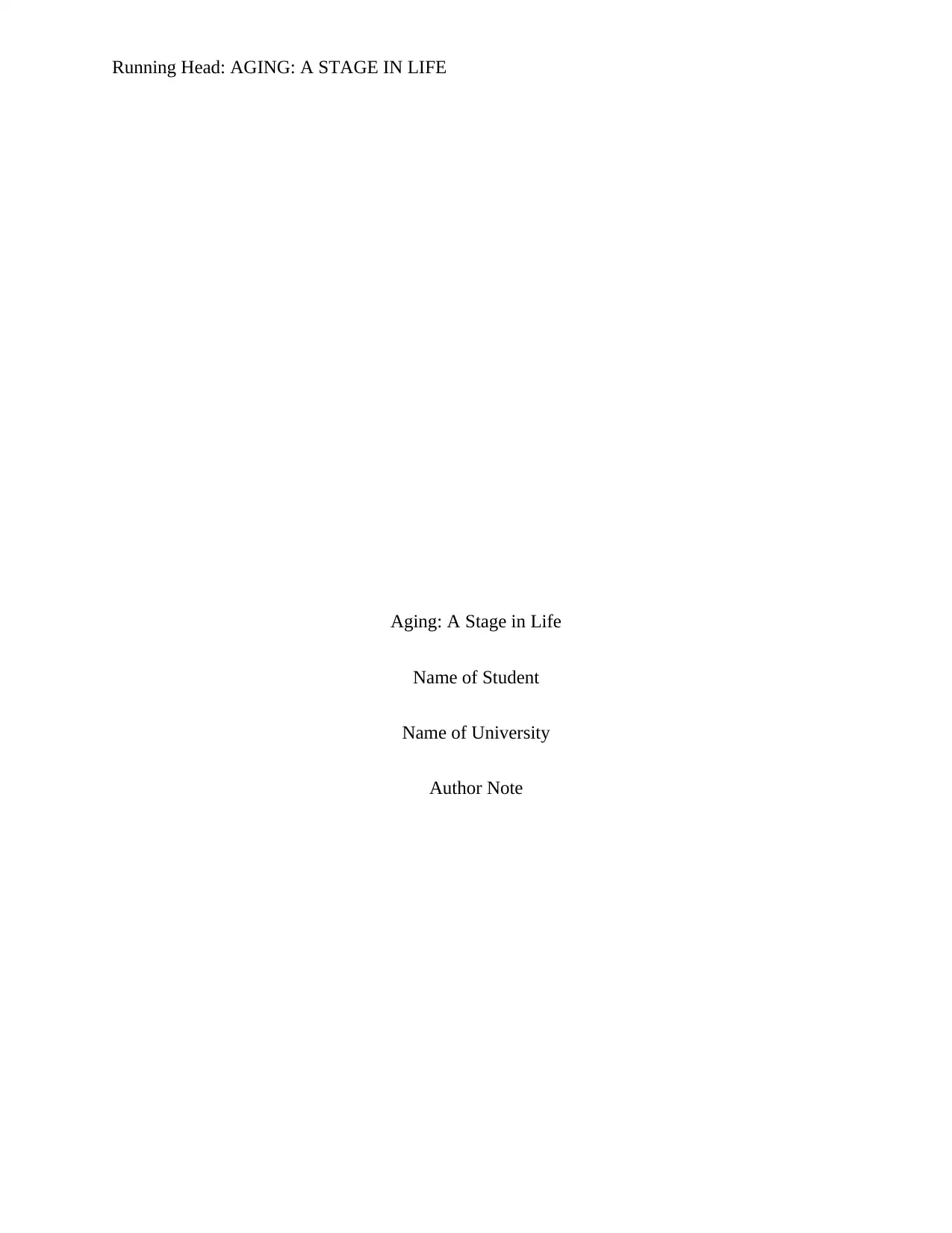
Running Head: AGING: A STAGE IN LIFE
Aging: A Stage in Life
Name of Student
Name of University
Author Note
Aging: A Stage in Life
Name of Student
Name of University
Author Note
Paraphrase This Document
Need a fresh take? Get an instant paraphrase of this document with our AI Paraphraser
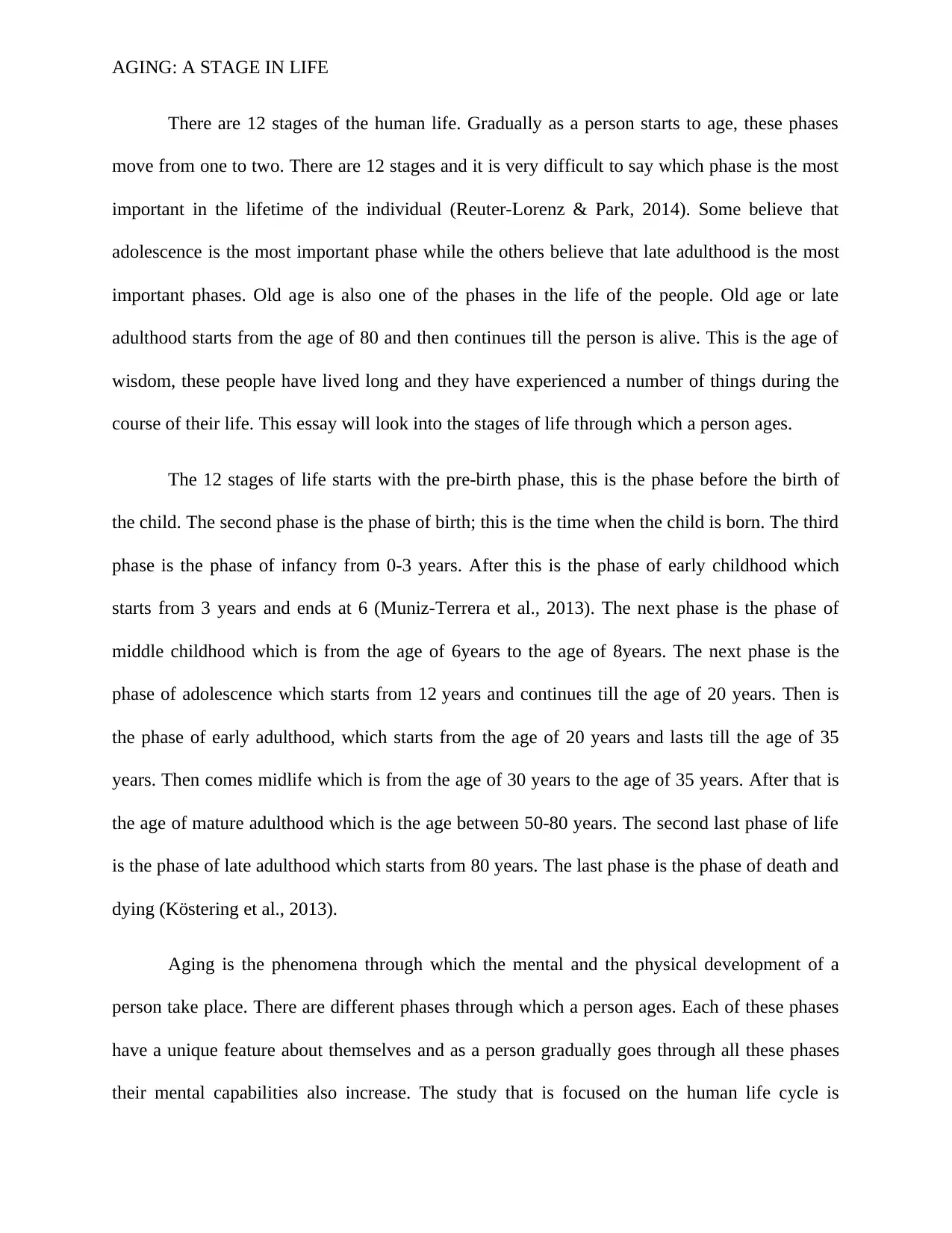
AGING: A STAGE IN LIFE
There are 12 stages of the human life. Gradually as a person starts to age, these phases
move from one to two. There are 12 stages and it is very difficult to say which phase is the most
important in the lifetime of the individual (Reuter-Lorenz & Park, 2014). Some believe that
adolescence is the most important phase while the others believe that late adulthood is the most
important phases. Old age is also one of the phases in the life of the people. Old age or late
adulthood starts from the age of 80 and then continues till the person is alive. This is the age of
wisdom, these people have lived long and they have experienced a number of things during the
course of their life. This essay will look into the stages of life through which a person ages.
The 12 stages of life starts with the pre-birth phase, this is the phase before the birth of
the child. The second phase is the phase of birth; this is the time when the child is born. The third
phase is the phase of infancy from 0-3 years. After this is the phase of early childhood which
starts from 3 years and ends at 6 (Muniz-Terrera et al., 2013). The next phase is the phase of
middle childhood which is from the age of 6years to the age of 8years. The next phase is the
phase of adolescence which starts from 12 years and continues till the age of 20 years. Then is
the phase of early adulthood, which starts from the age of 20 years and lasts till the age of 35
years. Then comes midlife which is from the age of 30 years to the age of 35 years. After that is
the age of mature adulthood which is the age between 50-80 years. The second last phase of life
is the phase of late adulthood which starts from 80 years. The last phase is the phase of death and
dying (Köstering et al., 2013).
Aging is the phenomena through which the mental and the physical development of a
person take place. There are different phases through which a person ages. Each of these phases
have a unique feature about themselves and as a person gradually goes through all these phases
their mental capabilities also increase. The study that is focused on the human life cycle is
There are 12 stages of the human life. Gradually as a person starts to age, these phases
move from one to two. There are 12 stages and it is very difficult to say which phase is the most
important in the lifetime of the individual (Reuter-Lorenz & Park, 2014). Some believe that
adolescence is the most important phase while the others believe that late adulthood is the most
important phases. Old age is also one of the phases in the life of the people. Old age or late
adulthood starts from the age of 80 and then continues till the person is alive. This is the age of
wisdom, these people have lived long and they have experienced a number of things during the
course of their life. This essay will look into the stages of life through which a person ages.
The 12 stages of life starts with the pre-birth phase, this is the phase before the birth of
the child. The second phase is the phase of birth; this is the time when the child is born. The third
phase is the phase of infancy from 0-3 years. After this is the phase of early childhood which
starts from 3 years and ends at 6 (Muniz-Terrera et al., 2013). The next phase is the phase of
middle childhood which is from the age of 6years to the age of 8years. The next phase is the
phase of adolescence which starts from 12 years and continues till the age of 20 years. Then is
the phase of early adulthood, which starts from the age of 20 years and lasts till the age of 35
years. Then comes midlife which is from the age of 30 years to the age of 35 years. After that is
the age of mature adulthood which is the age between 50-80 years. The second last phase of life
is the phase of late adulthood which starts from 80 years. The last phase is the phase of death and
dying (Köstering et al., 2013).
Aging is the phenomena through which the mental and the physical development of a
person take place. There are different phases through which a person ages. Each of these phases
have a unique feature about themselves and as a person gradually goes through all these phases
their mental capabilities also increase. The study that is focused on the human life cycle is
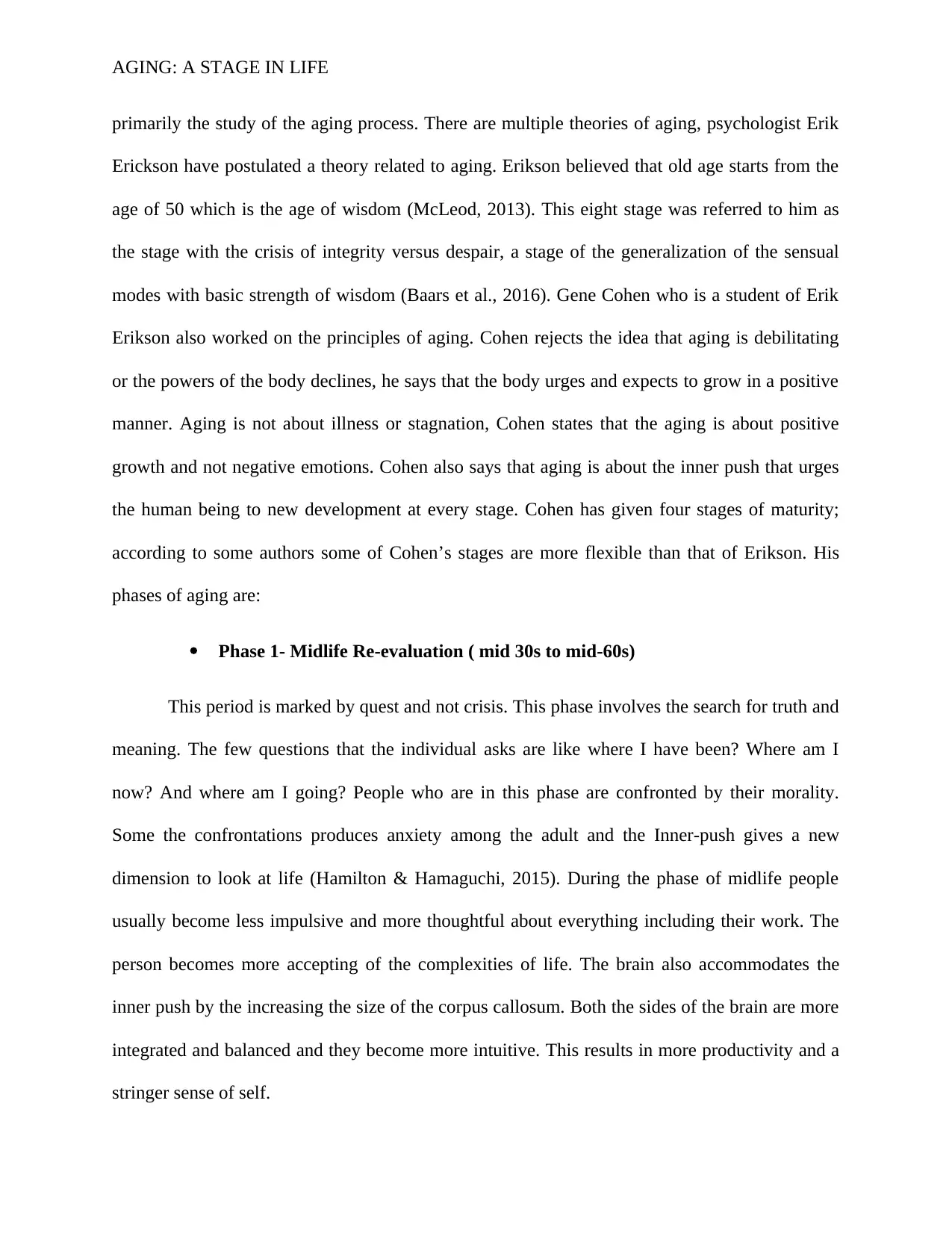
AGING: A STAGE IN LIFE
primarily the study of the aging process. There are multiple theories of aging, psychologist Erik
Erickson have postulated a theory related to aging. Erikson believed that old age starts from the
age of 50 which is the age of wisdom (McLeod, 2013). This eight stage was referred to him as
the stage with the crisis of integrity versus despair, a stage of the generalization of the sensual
modes with basic strength of wisdom (Baars et al., 2016). Gene Cohen who is a student of Erik
Erikson also worked on the principles of aging. Cohen rejects the idea that aging is debilitating
or the powers of the body declines, he says that the body urges and expects to grow in a positive
manner. Aging is not about illness or stagnation, Cohen states that the aging is about positive
growth and not negative emotions. Cohen also says that aging is about the inner push that urges
the human being to new development at every stage. Cohen has given four stages of maturity;
according to some authors some of Cohen’s stages are more flexible than that of Erikson. His
phases of aging are:
Phase 1- Midlife Re-evaluation ( mid 30s to mid-60s)
This period is marked by quest and not crisis. This phase involves the search for truth and
meaning. The few questions that the individual asks are like where I have been? Where am I
now? And where am I going? People who are in this phase are confronted by their morality.
Some the confrontations produces anxiety among the adult and the Inner-push gives a new
dimension to look at life (Hamilton & Hamaguchi, 2015). During the phase of midlife people
usually become less impulsive and more thoughtful about everything including their work. The
person becomes more accepting of the complexities of life. The brain also accommodates the
inner push by the increasing the size of the corpus callosum. Both the sides of the brain are more
integrated and balanced and they become more intuitive. This results in more productivity and a
stringer sense of self.
primarily the study of the aging process. There are multiple theories of aging, psychologist Erik
Erickson have postulated a theory related to aging. Erikson believed that old age starts from the
age of 50 which is the age of wisdom (McLeod, 2013). This eight stage was referred to him as
the stage with the crisis of integrity versus despair, a stage of the generalization of the sensual
modes with basic strength of wisdom (Baars et al., 2016). Gene Cohen who is a student of Erik
Erikson also worked on the principles of aging. Cohen rejects the idea that aging is debilitating
or the powers of the body declines, he says that the body urges and expects to grow in a positive
manner. Aging is not about illness or stagnation, Cohen states that the aging is about positive
growth and not negative emotions. Cohen also says that aging is about the inner push that urges
the human being to new development at every stage. Cohen has given four stages of maturity;
according to some authors some of Cohen’s stages are more flexible than that of Erikson. His
phases of aging are:
Phase 1- Midlife Re-evaluation ( mid 30s to mid-60s)
This period is marked by quest and not crisis. This phase involves the search for truth and
meaning. The few questions that the individual asks are like where I have been? Where am I
now? And where am I going? People who are in this phase are confronted by their morality.
Some the confrontations produces anxiety among the adult and the Inner-push gives a new
dimension to look at life (Hamilton & Hamaguchi, 2015). During the phase of midlife people
usually become less impulsive and more thoughtful about everything including their work. The
person becomes more accepting of the complexities of life. The brain also accommodates the
inner push by the increasing the size of the corpus callosum. Both the sides of the brain are more
integrated and balanced and they become more intuitive. This results in more productivity and a
stringer sense of self.
⊘ This is a preview!⊘
Do you want full access?
Subscribe today to unlock all pages.

Trusted by 1+ million students worldwide
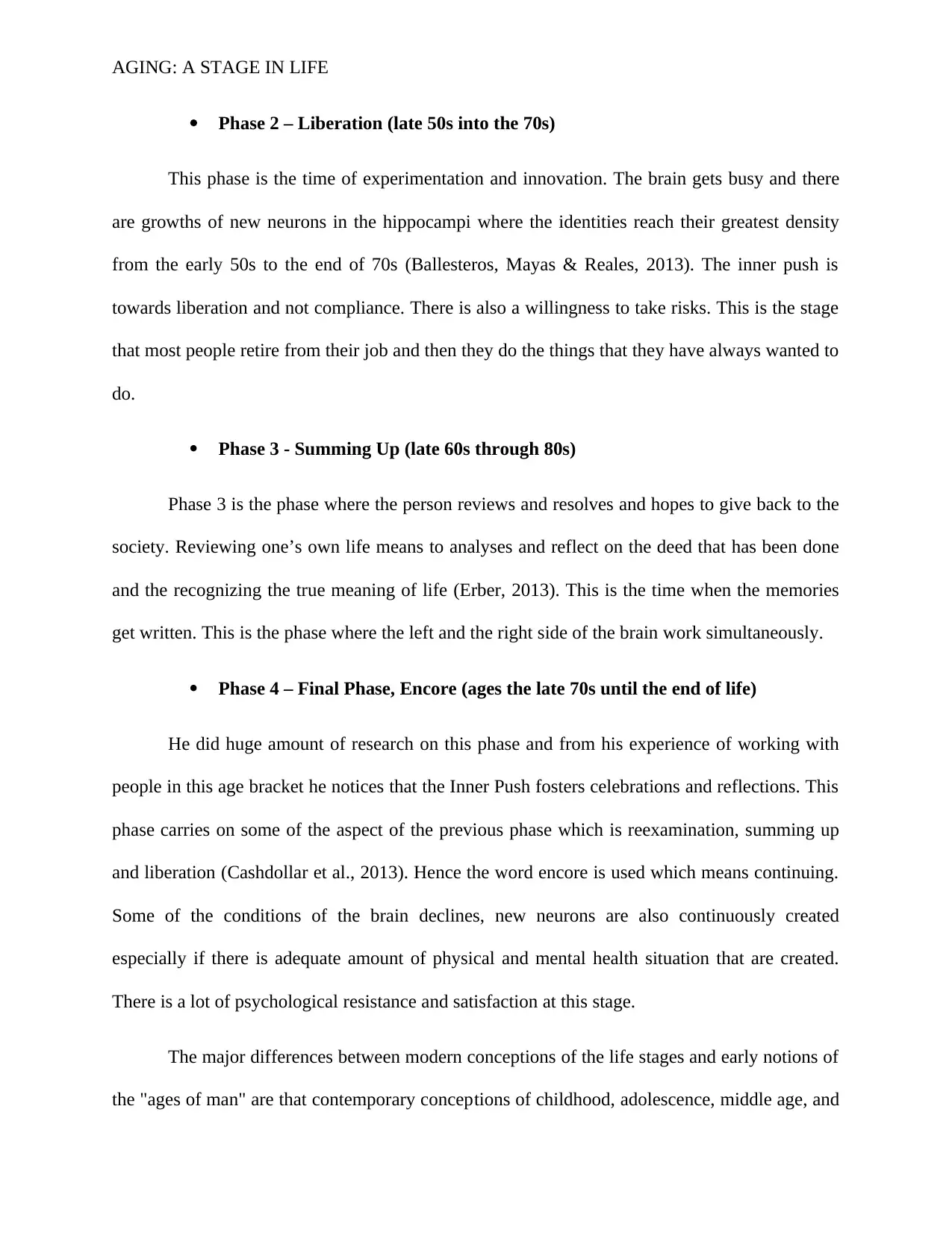
AGING: A STAGE IN LIFE
Phase 2 – Liberation (late 50s into the 70s)
This phase is the time of experimentation and innovation. The brain gets busy and there
are growths of new neurons in the hippocampi where the identities reach their greatest density
from the early 50s to the end of 70s (Ballesteros, Mayas & Reales, 2013). The inner push is
towards liberation and not compliance. There is also a willingness to take risks. This is the stage
that most people retire from their job and then they do the things that they have always wanted to
do.
Phase 3 - Summing Up (late 60s through 80s)
Phase 3 is the phase where the person reviews and resolves and hopes to give back to the
society. Reviewing one’s own life means to analyses and reflect on the deed that has been done
and the recognizing the true meaning of life (Erber, 2013). This is the time when the memories
get written. This is the phase where the left and the right side of the brain work simultaneously.
Phase 4 – Final Phase, Encore (ages the late 70s until the end of life)
He did huge amount of research on this phase and from his experience of working with
people in this age bracket he notices that the Inner Push fosters celebrations and reflections. This
phase carries on some of the aspect of the previous phase which is reexamination, summing up
and liberation (Cashdollar et al., 2013). Hence the word encore is used which means continuing.
Some of the conditions of the brain declines, new neurons are also continuously created
especially if there is adequate amount of physical and mental health situation that are created.
There is a lot of psychological resistance and satisfaction at this stage.
The major differences between modern conceptions of the life stages and early notions of
the "ages of man" are that contemporary conceptions of childhood, adolescence, middle age, and
Phase 2 – Liberation (late 50s into the 70s)
This phase is the time of experimentation and innovation. The brain gets busy and there
are growths of new neurons in the hippocampi where the identities reach their greatest density
from the early 50s to the end of 70s (Ballesteros, Mayas & Reales, 2013). The inner push is
towards liberation and not compliance. There is also a willingness to take risks. This is the stage
that most people retire from their job and then they do the things that they have always wanted to
do.
Phase 3 - Summing Up (late 60s through 80s)
Phase 3 is the phase where the person reviews and resolves and hopes to give back to the
society. Reviewing one’s own life means to analyses and reflect on the deed that has been done
and the recognizing the true meaning of life (Erber, 2013). This is the time when the memories
get written. This is the phase where the left and the right side of the brain work simultaneously.
Phase 4 – Final Phase, Encore (ages the late 70s until the end of life)
He did huge amount of research on this phase and from his experience of working with
people in this age bracket he notices that the Inner Push fosters celebrations and reflections. This
phase carries on some of the aspect of the previous phase which is reexamination, summing up
and liberation (Cashdollar et al., 2013). Hence the word encore is used which means continuing.
Some of the conditions of the brain declines, new neurons are also continuously created
especially if there is adequate amount of physical and mental health situation that are created.
There is a lot of psychological resistance and satisfaction at this stage.
The major differences between modern conceptions of the life stages and early notions of
the "ages of man" are that contemporary conceptions of childhood, adolescence, middle age, and
Paraphrase This Document
Need a fresh take? Get an instant paraphrase of this document with our AI Paraphraser
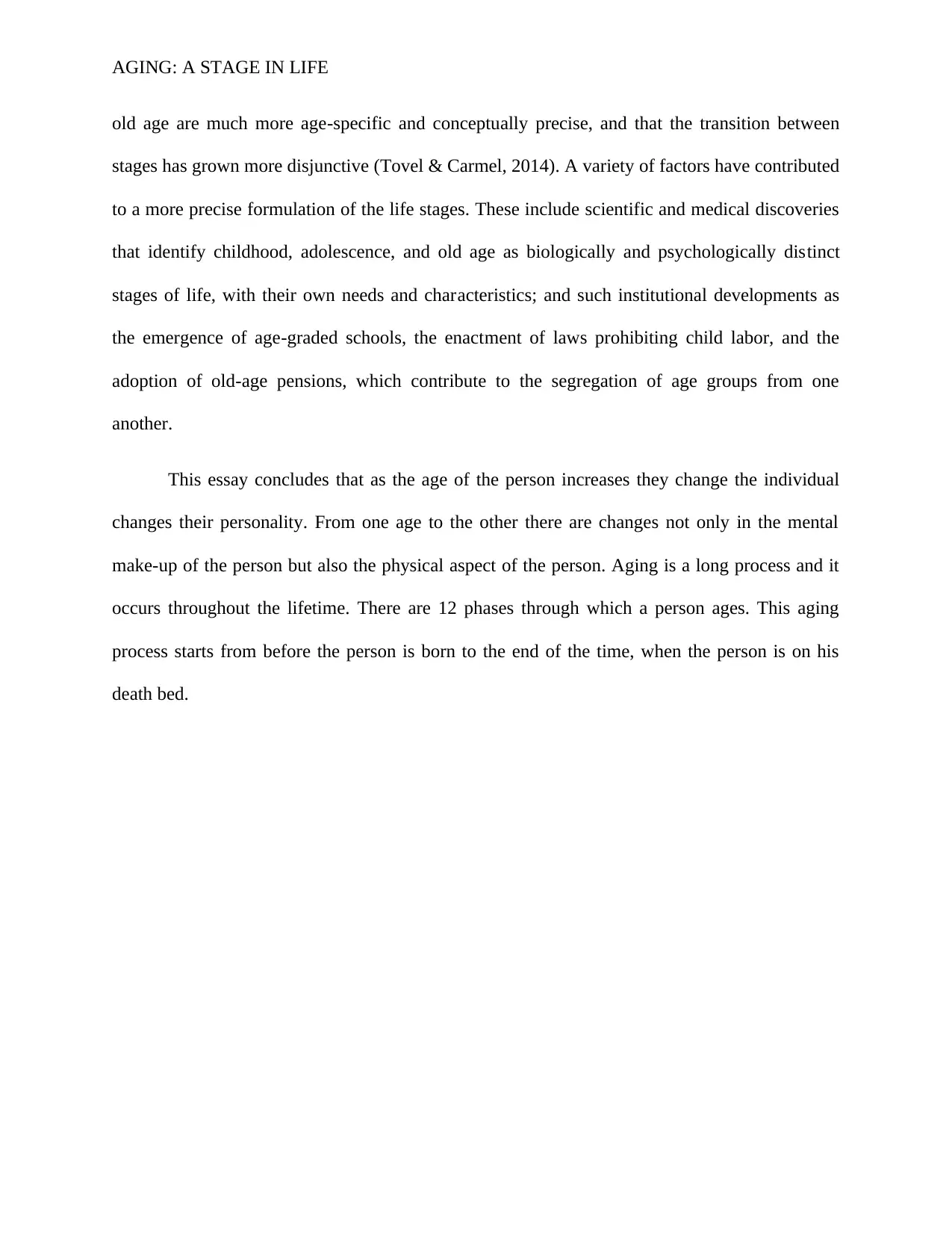
AGING: A STAGE IN LIFE
old age are much more age-specific and conceptually precise, and that the transition between
stages has grown more disjunctive (Tovel & Carmel, 2014). A variety of factors have contributed
to a more precise formulation of the life stages. These include scientific and medical discoveries
that identify childhood, adolescence, and old age as biologically and psychologically distinct
stages of life, with their own needs and characteristics; and such institutional developments as
the emergence of age-graded schools, the enactment of laws prohibiting child labor, and the
adoption of old-age pensions, which contribute to the segregation of age groups from one
another.
This essay concludes that as the age of the person increases they change the individual
changes their personality. From one age to the other there are changes not only in the mental
make-up of the person but also the physical aspect of the person. Aging is a long process and it
occurs throughout the lifetime. There are 12 phases through which a person ages. This aging
process starts from before the person is born to the end of the time, when the person is on his
death bed.
old age are much more age-specific and conceptually precise, and that the transition between
stages has grown more disjunctive (Tovel & Carmel, 2014). A variety of factors have contributed
to a more precise formulation of the life stages. These include scientific and medical discoveries
that identify childhood, adolescence, and old age as biologically and psychologically distinct
stages of life, with their own needs and characteristics; and such institutional developments as
the emergence of age-graded schools, the enactment of laws prohibiting child labor, and the
adoption of old-age pensions, which contribute to the segregation of age groups from one
another.
This essay concludes that as the age of the person increases they change the individual
changes their personality. From one age to the other there are changes not only in the mental
make-up of the person but also the physical aspect of the person. Aging is a long process and it
occurs throughout the lifetime. There are 12 phases through which a person ages. This aging
process starts from before the person is born to the end of the time, when the person is on his
death bed.
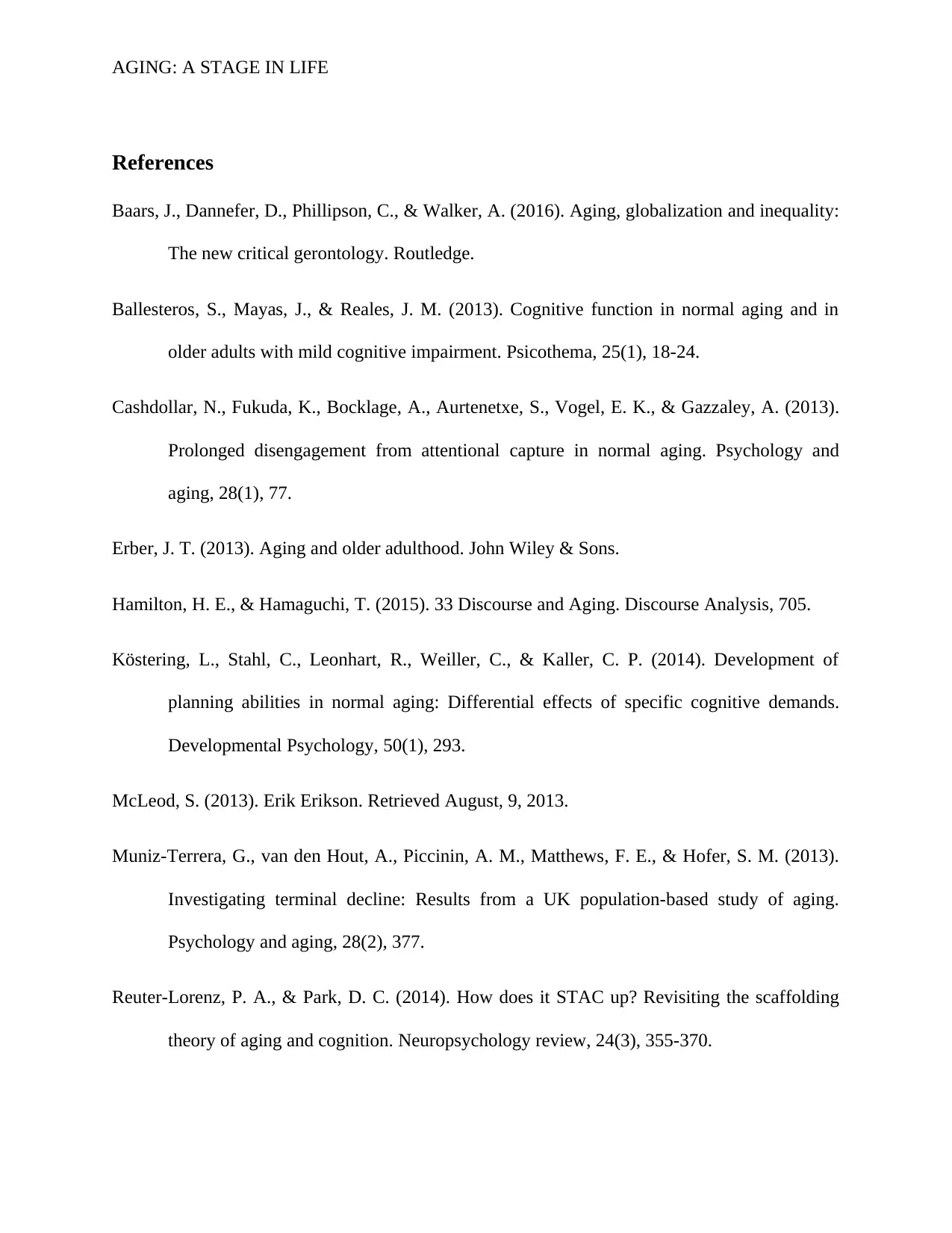
AGING: A STAGE IN LIFE
References
Baars, J., Dannefer, D., Phillipson, C., & Walker, A. (2016). Aging, globalization and inequality:
The new critical gerontology. Routledge.
Ballesteros, S., Mayas, J., & Reales, J. M. (2013). Cognitive function in normal aging and in
older adults with mild cognitive impairment. Psicothema, 25(1), 18-24.
Cashdollar, N., Fukuda, K., Bocklage, A., Aurtenetxe, S., Vogel, E. K., & Gazzaley, A. (2013).
Prolonged disengagement from attentional capture in normal aging. Psychology and
aging, 28(1), 77.
Erber, J. T. (2013). Aging and older adulthood. John Wiley & Sons.
Hamilton, H. E., & Hamaguchi, T. (2015). 33 Discourse and Aging. Discourse Analysis, 705.
Köstering, L., Stahl, C., Leonhart, R., Weiller, C., & Kaller, C. P. (2014). Development of
planning abilities in normal aging: Differential effects of specific cognitive demands.
Developmental Psychology, 50(1), 293.
McLeod, S. (2013). Erik Erikson. Retrieved August, 9, 2013.
Muniz-Terrera, G., van den Hout, A., Piccinin, A. M., Matthews, F. E., & Hofer, S. M. (2013).
Investigating terminal decline: Results from a UK population-based study of aging.
Psychology and aging, 28(2), 377.
Reuter-Lorenz, P. A., & Park, D. C. (2014). How does it STAC up? Revisiting the scaffolding
theory of aging and cognition. Neuropsychology review, 24(3), 355-370.
References
Baars, J., Dannefer, D., Phillipson, C., & Walker, A. (2016). Aging, globalization and inequality:
The new critical gerontology. Routledge.
Ballesteros, S., Mayas, J., & Reales, J. M. (2013). Cognitive function in normal aging and in
older adults with mild cognitive impairment. Psicothema, 25(1), 18-24.
Cashdollar, N., Fukuda, K., Bocklage, A., Aurtenetxe, S., Vogel, E. K., & Gazzaley, A. (2013).
Prolonged disengagement from attentional capture in normal aging. Psychology and
aging, 28(1), 77.
Erber, J. T. (2013). Aging and older adulthood. John Wiley & Sons.
Hamilton, H. E., & Hamaguchi, T. (2015). 33 Discourse and Aging. Discourse Analysis, 705.
Köstering, L., Stahl, C., Leonhart, R., Weiller, C., & Kaller, C. P. (2014). Development of
planning abilities in normal aging: Differential effects of specific cognitive demands.
Developmental Psychology, 50(1), 293.
McLeod, S. (2013). Erik Erikson. Retrieved August, 9, 2013.
Muniz-Terrera, G., van den Hout, A., Piccinin, A. M., Matthews, F. E., & Hofer, S. M. (2013).
Investigating terminal decline: Results from a UK population-based study of aging.
Psychology and aging, 28(2), 377.
Reuter-Lorenz, P. A., & Park, D. C. (2014). How does it STAC up? Revisiting the scaffolding
theory of aging and cognition. Neuropsychology review, 24(3), 355-370.
⊘ This is a preview!⊘
Do you want full access?
Subscribe today to unlock all pages.

Trusted by 1+ million students worldwide
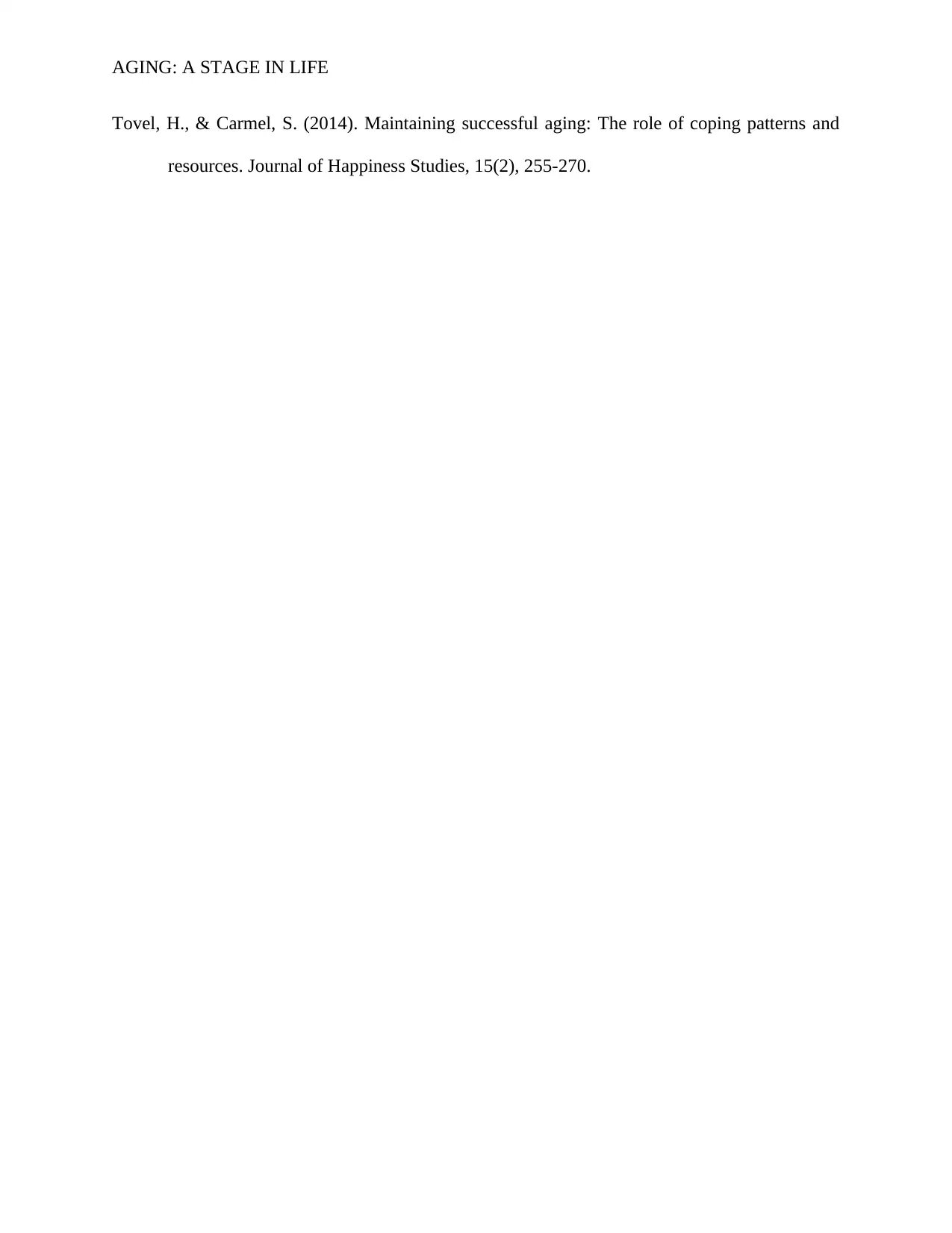
AGING: A STAGE IN LIFE
Tovel, H., & Carmel, S. (2014). Maintaining successful aging: The role of coping patterns and
resources. Journal of Happiness Studies, 15(2), 255-270.
Tovel, H., & Carmel, S. (2014). Maintaining successful aging: The role of coping patterns and
resources. Journal of Happiness Studies, 15(2), 255-270.
1 out of 7
Related Documents
Your All-in-One AI-Powered Toolkit for Academic Success.
+13062052269
info@desklib.com
Available 24*7 on WhatsApp / Email
![[object Object]](/_next/static/media/star-bottom.7253800d.svg)
Unlock your academic potential
Copyright © 2020–2025 A2Z Services. All Rights Reserved. Developed and managed by ZUCOL.




